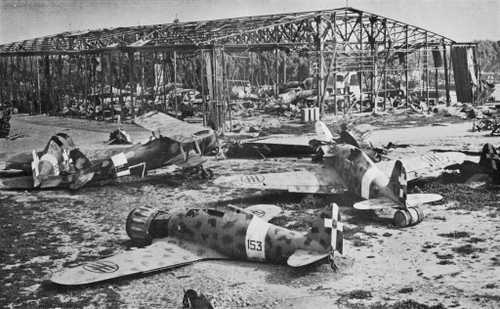
Italian Forces
Dangerous airdromes
The following text is an interesting article published on the July 1943 issue of the Intelligence Bulletin, a monthly magazine published by US Military Intelligence Service throughout WWII to inform officers and enlisted men of the latest enemy tactics and weapons (see Lonesentry.com). The article, "Methods of Obstructing Airdromes", is undoubtedly inspired by latest experiences on North Africa. “The Germans and Italians are expert at rendering airdromes temporarily or permanently unserviceable, and have employed a number of methods of obstructing and destroying airfields and landing grounds from which they have been forced to withdraw. Vehicles, heavy construction equipment, logs, drums filled with rocks, and other movable obstacles are placed on runways and landing areas to prevent Allied forces from using them and, at the same time, to keep them available for the Axis. Nearby areas which might also be used for landing are blocked with more permanent obstacles, such as steel posts, cables, timbers, and ditches. When an airdrome can no longer be defended, it is demolished by explosives, plowed up or scarred with deep trenches, and then liberally sown with mines and booby traps. In North Africa the roads in the vicinity of certain abandoned Axis airdromes were found to have been mined very carefully to delay the Allied advance and give the Germans time to destroy the surfaces of their landing fields. The thoroughness with which the landing fields themselves were mined varied greatly; some had received only slight attention, whereas others had been mined in the most elaborate manner possible. On one airdrome the ground was furrowed in patterns resembling giant fingerprints. Effective furrows were also cut by a small metal wedge about 8 inches wide, with the cutting edge leveled back at 45 degrees. Ordinary plows were also used. Z-shaped trenches and irregular bomb craters were found in another field; and in still another, the runways had been crossed with trenches and the landing ground further obstructed by wrecked aircraft, motor vehicles, and the familiar emergency device of barrels filled with rocks. The Axis of course destroys its hangars whenever this is possible. Several types of booby traps are likely to be planted before an airfield is abandoned. For example, mines made up of several charges packed in a wooden box, and the whole buried in a landing strip, may be booby-trapped in as many as three ways. The lids of these improvised wooden box mines are open about 3/4 inch. The box explodes if it is lifted, or if the lid is either lifted or stepped on. "S" mine crates may be buried in the ground, with metal spikes protruding to damage tires, and fitted with anti-lifting devices. Gasoline, oil, and water cans and drums may be partly buried in the runways, and similarly fitted with anti-lifting devices. Booby traps are also fitted to the movable parts of abandoned planes and vehicles. Temporary obstructions, such as barbed wire, fences, and logs, have been observed on temporarily unused fields in France, Belgium, and Holland, and also on portions of active fields. Another portable obstruction now greatly favored by the Germans is an arrangement of beams or metal rails, lying crossed on the ground, or standing and secured near the top, like the poles of an Indian wigwam. All these obstacles, of course, can be cleared when the fields are needed, and replaced when the occasion demands. A semipermanent type of obstacle which has been observed in occupied countries consists of an upright tree fixed in a cement block. Such obstacles are sometimes supplemented by stakes driven into the ground at irregular intervals, and the approaches to the field closed by networks of barbed wire. In one instance an airfield had been completed, and then evidently found unsuitable; it was made unserviceable for landings by a series of evenly-spaced trenches 16 inches deep. Large felled trees, which take an appreciable time to remove, are also used as semipermanent obstacles”. In picture the large Castelbenito Airport, near Tripoli, completely destroyed before the Axis forces retreat with many aircraft, note MC.200, G.50 and CR.42, voluntarily disabled. Victor Sierra
2281 Views
1/2/2012
